Containers
Containers are placeholders, they can be filled with one article template per container.
(Container with multiple article templates is only possible when using GridContainers).
Graphic frames (Tool Rectangle Frame) of any template in InDesign can be tagged as containers using the »PFContainer« tag. Attributes can be used to define which contents can be inserted into the PFContainer block.
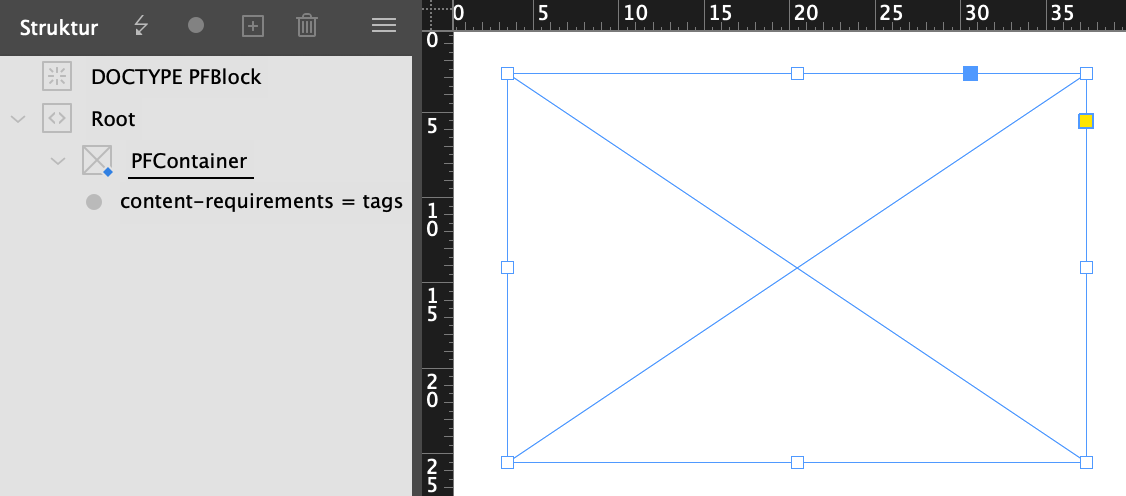
Articletemplates
The related article templates must be created separately both in InDesign and in printformer (Configure printformer templates).
Make sure that their format is not larger than the size of the container (otherwise they will be inserted with the required offset). If the articles are smaller, they can be aligned (horizontally and vertically) or moved within the container. Article templates should always be created without bleed. (If desired, an additional contour SVG can be created so that elements that extend beyond the working area of the article template are cut off).
If the content of text and/or image blocks is to be transferred when changing the article template, the tag content-identifier must be added to the respective block.
If article template texts are to be filled via API or feed, they must be tagged as placeholders.
After master and article templates have been configured in printformer, the articles must be assigned to the master template. This means that when editing the template in the editor, the catalog templates tab automatically appears from which the articles can be inserted into the container blocks using drag&drop. (Via the attribute catalog-template-identifier the container is already filled with the selected catalog template when creating the draft).
If containers are used with the Feed Feature, they can also be filled with multiple products (as long as the corresponding article templates fit into one container multiple times).
They will be arranged in order from top to bottom and left to right.
Container in Container
An article template can also be created with additional containers. For example, to offer users greater design freedom in the editor; a (page) template that has a large container can be filled with article templates that each have several containers. The standard articles are then inserted.
Set up template in printformer
The desired article templates must be assigned to the (master) template:
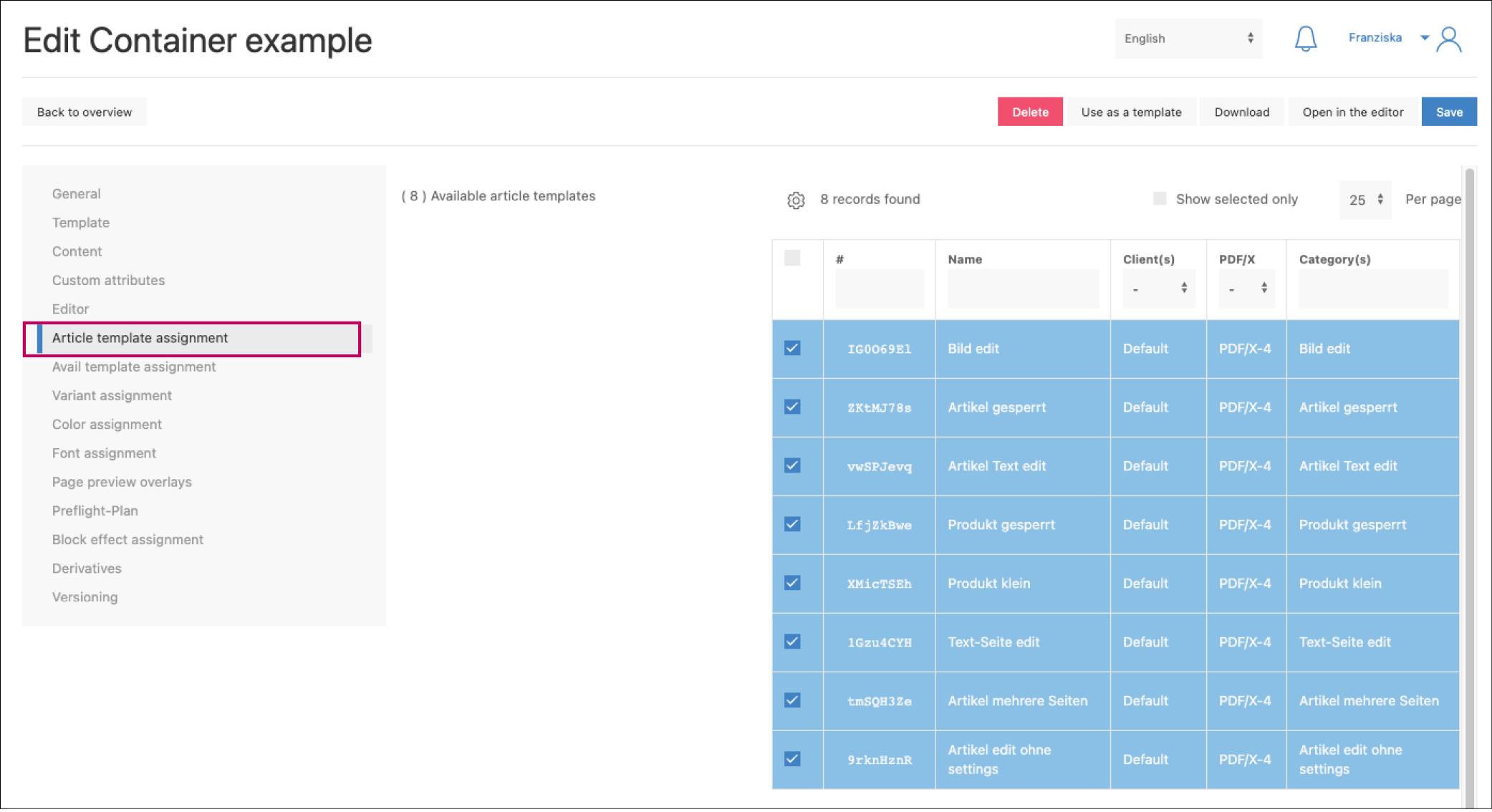
Under Editor, the following settings can be selected:
Hide article template overview in editor: Use this option if the container is pre-filled and article templates should not be shown to the user in the editor.
User Templates verwenden Special feature

If this checkbox is enabled, users can create their own article templates in the editor and save them to their user profile.Tag filter mode
Display article templates based on the content requirements per page. In the sidebar, only those article templates will appear that match the container requirements of the page and are thus allowed in the container.Display article templates according to the content requirements per page: only the article templates that match the container requirements contained on the page are displayed in the sidebar
Sorting: Choose between the default order (based on the creation date of the article templates) or alphanumeric sorting.
Always transfer latest content: If this setting is enabled, the most recently edited content will always be used during a layout change. If it is disabled, the content originally entered in the respective layout will be used instead.


Attributes | ||
|
The values listed under name are individual attributes of the tag PFContainer and are entered as name, the possible values are listed in the second column. If the cell is empty, the value is freely selectable. | ||
|---|---|---|
name | value (Limitations) | Usage |
One or more tags (comma-separated) used to restrict the possible contents of the container. | ||
| One or more DataKeys (comma separated) used to search for content for the block in the current data sources. | |
Integer | Page number (starting with 1) of the article template page that should be placed in the container. Default value: 1 | |
h-align | left, center, right | Automatic horizontal alignment of the article template |
v-align | top, center, bottom | Automatic veritical alignment of the article template |
settings | Valid JSON format |
Scaling settings (block-scale) on the container are not transferred to the elements in the article template. |
Identifier of an already existing catalog template | When creating a draft from this template, the container is already filled with a catalog template (created in the backend). This way, the assignment of article templates in the master template configuration can be omitted. | |
identifier | Freely definable string used for addressing the container. Used when the template is prefilled (using catalog-template-identifier). | |
content-identifier |
If the content identifier is set directly on the container, the content including the article template is transferred when the layout is changed The transfer when changing the layout only works correctly if the “new” container has not yet been assigned an article template (via prefill or catalog-template-identifier). And if the containers have the same size. | |
scale-to-fit | true, false (Default: false) | If this setting is set to “true”, the article templates that are dragged into the container are resized to fit the container. The scaling is only upwards. |
Editor Settings
In the General Settings > Editor > Article template/Container the following settings can be made for the appearance in the editor:
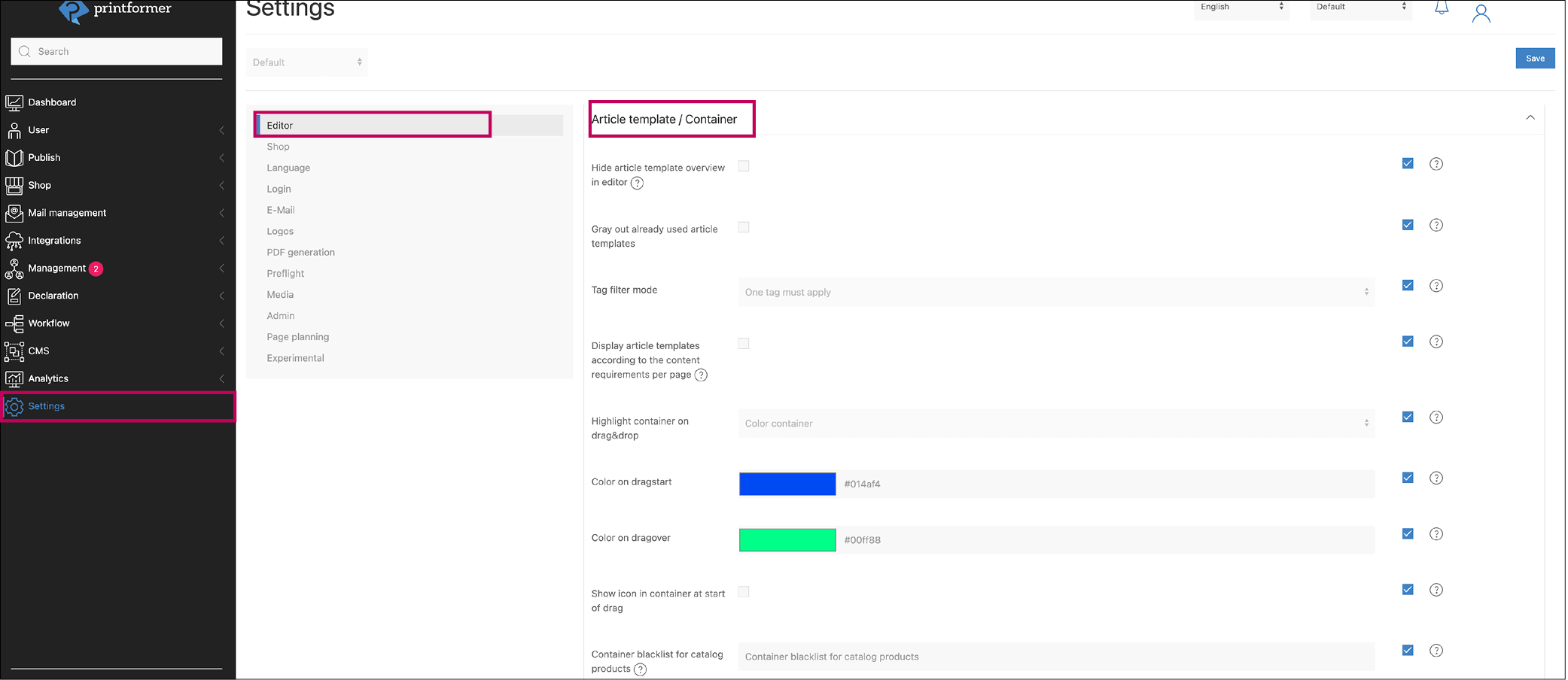
Setting | Description |
|---|---|
Hide article template overview in editor | sinnvoller Einsatz wenn pro Container nur ein Artikeltemplate zur Verfügung steht |
Gray out already used article templates | Article templates that have already been dragged into a container are grayed out in the sidebar |
Tag filter mode | This specifies whether the container can be filled with an article template if it contains only one of the predefined tags or whether it must contain all tags. |
Display article templates according to the content requirements per page | If there is a container without content-requirements on the current page, no filtering will be performed. |
Highlight container on drag&drop | Behavior of the container(s) when dragging an article template over: outline or area (container) of the container is colored (highlighted) |
Color on dragstart | Highlight color when selecting an article template |
Color on dragover | Highlight color when dragging an article template into the container |
Show icon in container at start of drag | (in addition to the color highlight of the container) an icon appears in the container |
Container blacklist for catalog products | comma-separated list of content-requirements for containers which should not be highlighted during drag&drop of article templates |
Always transfer latest content | If this setting is activated, the last edited content is always applied when the layout is changed. Otherwise, the content previously entered in this layout is displayed when the layout is changed. |
Scaling function of article templates
If the same article templates are used for containers of different sizes and are to be scaled accordingly, the scale-to-fit attribute can be added to the container:

Article templates must be created in the smallest possible format (problems can occur if the page dimensions transferred are smaller than the default format in the template). When scaling, the basic format should be retained, e.g. a portrait format must not become a landscape format.
*Set tags for articles
The content-requirements attribute can be used in the (IDML) template to specify the articles with which the container can be filled. The tags can be defined freely, but must also be added to the corresponding article templates in the printformer. (The tags are typed/copied into the Tags field and are then added by pressing the Enter key).
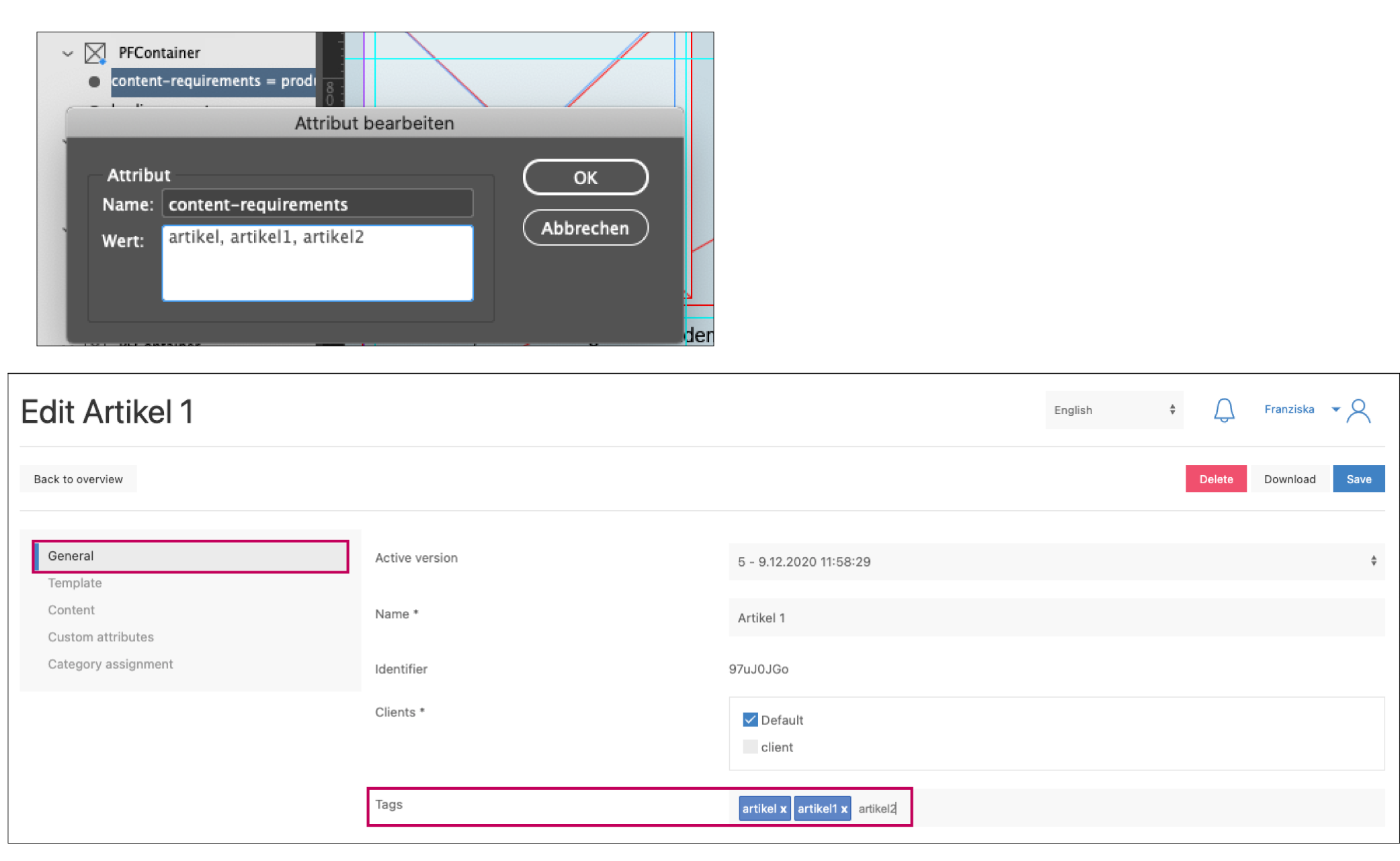
In the admin settings, the tag filter mode is defined for all containers. This determines whether the container can be filled with an article template if it contains only one of the predefined tags or whether it must contain all tags.

**Multi-page article templates
If an article template consists of several pages, the containers in which it is to be inserted must first be grouped and additionally provided with information about the desired number of pages.
For this purpose, the attribute content-group is used to assign the same value (freely definable) to all containers belonging to the group. Subsequently, the desired page number of the article template is determined for the container via the attribute source-page.

***Container Prefilling
In the template configuration, the containers included in the template are listed (page by page) under Content:
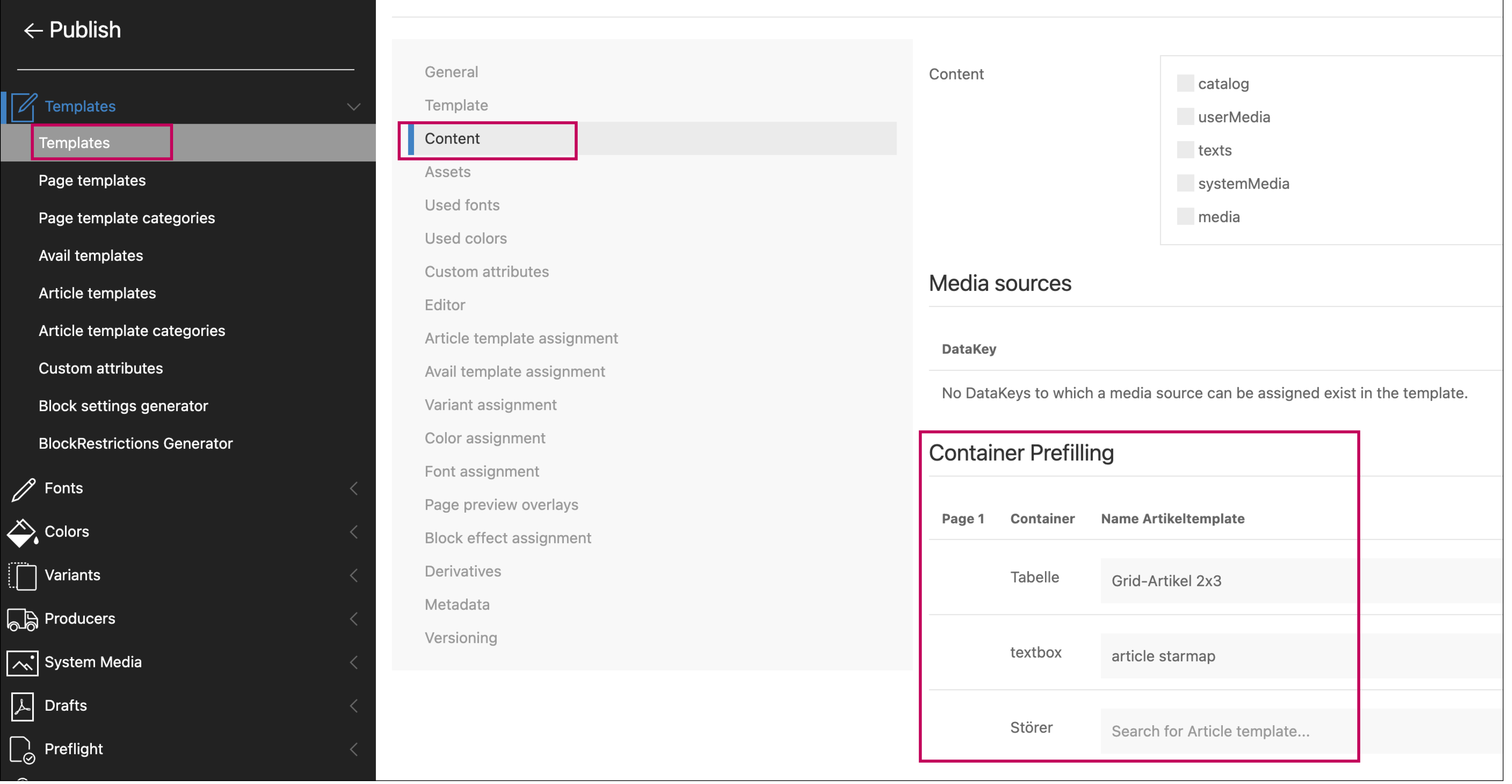
If the identifier attribute has been added to the container, the value entered there is displayed as the container name (otherwise an automatically generated name is used).
In the right column, the article templates already assigned via catalog-template-identifier are displayed, or an article template can be searched for (by entering the first letters of the article template name) and then assigned as prefill.
Also already assigned article templates can be overwritten here.
page planning with pre-filled containers
If catalog templates are already assigned to the containers in the IDML file and then filled with a product in the editor, only the product is initially removed via the Empty container button (the article template remains). If the button is then selected a second time, the article template is also removed from the container.
